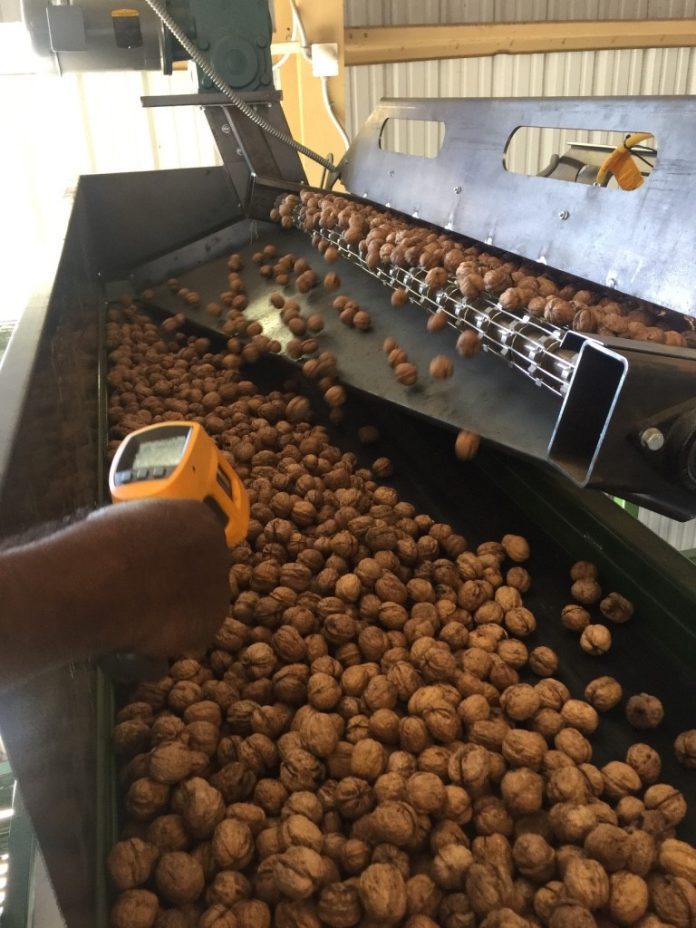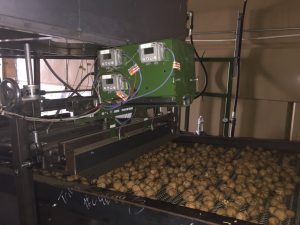
A walnut drying technique that uses infrared to remove moisture from the shell holds promise as the industry looks for ways to reduce energy use in the drying process.
“We found that if we use sequential infrared and hot-air drying, we can save around 20% of the energy use, and it is roughly 20% faster to dry,” said UC Davis Adjunct Professor in Biology and Agriculture Engineering Zhongli Pan, who developed the technique.
Pan’s method involves pre-drying walnut shells by exposing them to infrared, or electromagnetic radiation, after washing and prior to depositing walnuts into dryer bins.
Pan said he developed the method under the premise that newly harvested walnut shells have a much higher moisture content than kernels and can restrict the drying rate.
“Also, they need to be washed, so that means the surface has a lot of water,” he said. “I thought, okay, why don’t we use the infrared, or use high temperature at the beginning to quickly remove the moisture and still maintain relatively low moisture in the kernel, which is beneficial for the quality of the product.”
Exposing walnut shells to high air temperatures early in the process, which is feasible in almonds because they are more heat tolerant, was not an option in walnuts, Pan said. Infrared technology, however, offered an alternative.
Pan, who also worked for USDA, said he first discovered the benefits of infrared while working with rice and vegetables. “We found this was very effective,’’ he said. “It heated the produce really quickly and it was energy efficient and reduced processing time.”
In walnuts, Pan again found that infrared “can provide a timely solution to reduce drying time and energy usage and cost,” he wrote in a research paper he and others developed after experimenting with the process. The paper characterized existing walnut drying practices as “energy intensive” and stated that product losses of up to 3% can occur when walnuts are dried by heated air after harvesting and washing.
Regulation Issues
Roger Isom, President and CEO of the Western Agricultural Processors Association (WAPA), said that WAPA has been looking to improve conventional drying processes in walnuts since its formation in 2009, both to improve efficiencies and to get ahead of potential air pollution regulation issues.
“We are getting pressure that continues to grow as the regulators get down to smaller and smaller sources, where we may have to install what they call low-NOx, or low-emissions burners on our dryers,” Isom said.
“Every time we build a new walnut huller or expand it, that issue comes up,” he said. “And, for the most part, it is not cost-effective to install a low-NOx burner. Typically, those burners cost as much as two-times the cost of a conventional burner. And typically, they have a separate combustion air fan from the main fan, so there are additional electrical costs as well.
“So, getting away from that combustion-type drying is going to be helpful,” Isom said.
In addition, Isom said there are quality reasons for pursuing improved drying techniques.
“In conventional drying, where we put the walnuts into stadium dryer bins, we blow hot air from the bottom up through the top of bin,” Isom said. “So, what happens is you get really dry walnuts on the bottom and not so dry on the top. So, if you dry long enough to where you get the top ones to the point you want them, you’ve probably overdried the ones on the bottom, which can affect the quality of walnuts.
“It is not an even, throughout-the-bin drying process,” Isom said.
Isom said another option, and one being studied by researchers at USDA-ARS, could be to add outlets throughout the drying bin to obtain a more even drying process, a technique that also could reduce the drying time, another goal of WAPA.
“If you are reducing the drying time, you are burning less fuel and you are getting the walnuts dried faster and saving money,” he said.
“As the industry deals with low prices, finding ways to cut costs becomes challenging, but if I can cut fuel costs and labor costs in the sense that I can get them dried faster and get them out of there, making my process more efficient, then I am going to be saving some money that way,” Isom said.

No Ill Effects
As part of his research, Pan said he looked at whether using infrared to pre-dry walnuts would adversely affect cracking characteristics or kernel quality. His findings showed no ill effects on either characteristic.
“Removing the surface layer of water did not affect the cracking and it did not affect kernel quality,” Pan said. The method can, in fact, improve nut quality in cases where moisture content is excessive by preventing moisture from moving into the walnut, he said. And it eliminates a concern of walnut hullers, who at times will over-dry walnuts to avoid issues with mold when moisture levels are high.
Pan believes that adopting the system will involve only minor adjustments to existing drying systems and could be done at a relatively low cost. The main expense in bringing on the system, he said, is the cost of the infrared heating equipment.
Still, the industry has been slow to adopt the technology. “We fully demonstrated the benefits,” he said, “however, we need the industry to take a step and to use the technology.
“I know people are interested,” he added.
With the volume of walnuts coming into hullers increasing annually and concerns over air pollution hanging over the industry, Isom, for one, believes the system could have a place in the industry. “The thing I would like to see is how they can do it in real time on a commercial scale dehydrator,” he said.
“But, if I can reduce the time that they are drying, if I can go from 24 hours down to 22, or if I can go from 24 hours down to 20, and I can get those out quicker, then that is going to help. It is reducing fuel, and I’m getting them out of there and bringing in the next ones,” Isom said.
“Especially when the Chandlers are coming in. They are all coming off at the same time. We are just overwhelmed. You want to turn and burn, if you will,” he said.
“Any process that we can look at, whether that is infrared or something else, where we can reduce that drying time or do a better job of drying, I think that is going to be something we are going to shoot for,” he said.
“The results I’ve seen seem to indicate that it works,” Isom said of the infrared technology. “So, if this process can do it quicker, I think that is definitely where we want to go.”















